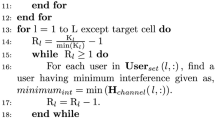Abstract
Massive multiple-input multiple-output (M-MIMO) has been elected to be the bridge toward the fifth generation, however, the problem of pilot contamination (PC) bounds this emerging technology. This paper provides a novel mitigating strategy, which is referred to as pilot contamination suppression (PCS)-based coordination. The PCS strategy aims to, properly, coordinate the base stations (BSs) of a set of cells; hence, each BS can, accurately, estimates the channel state information of its supported user equipments (UEs). This without determining the angle-of-arrivals of the contaminating signals, but through controlling the allocation of the pilot sequences to the UEs of each cell. Simulation results prove the effectiveness of the proposed PCS strategy in multi-cell M-MIMO systems.






Similar content being viewed by others
References
Marzetta, T. L. (2010). Noncooperative cellular wireless with unlimited numbers of base station antennas. IEEE Transactions on Wireless Communications, 9(11), 3590–3600.
Rusek, F., et al. (2013). Scaling up MIMO: Opportunities and challenges with very large arrays. IEEE Signal Processing Magazine, 30(1), 40–60.
Belhabib, A., et al. (2020). Pilot Assignment vs Soft Pilot Reuse to Surpass the Pilot Contamination Problem: A Comparative Study in the Uplink Phase. In: Belkasmi M., Ben-Othman J., Li C., Essaaidi M. (eds) Advanced Communication Systems and Information Security. ACOSIS 2019. Communications in Computer and Information Science, vol 1264. Springer.
Boulouird, M., Belhabib, A., & Riadi, A. (2021). Encryption based strategy to overcome the problem of pilot contamination within multi-cellular massive MIMO systems. Wireless Personal Commununications, 119, 2639–2655.
Yin, H., et al. (2013). A coordinated approach to channel estimation in large-scale multiple-antenna systems. IEEE Journal on Selected Areas in Communications, 31(2), 264–273.
Zhu, X., et al. (2016). Soft pilot reuse and multicell block diagonalization precoding for massive MIMO systems. IEEE Transactions on Vehicular Technology, 65(5), 3285–3298.
Fan, J., et al. (2018). Pilot contamination mitigation by fractional pilot reuse with threshold optimization in massive MIMO systems. Elsevier Digital Signal Processing, 78, 197–204.
Fernandes, F., et al. (2013). Inter-cell interference in noncooperative TDD large scale antenna systems. IEEE Journal on Selected Areas in Communications, 31(2), 192–201.
Chen, J., et al. (2017). A low complexity pilot scheduling algorithm for massive MIMO. IEEE Wireless Communications Letters, 6(1), 18–21.
Zhu, X., et al. (2015). Graph coloring based pilot allocation to mitigate pilot contamination for multi-cell massive MIMO systems. EEE Communications Letters, 19(10), 1842–1845.
Zhu, X., et al. (2017). Weighted-graph-coloring-based pilot decontamination for multicell massive MIMO systems. IEEE Transactions on Vehicular Technology, 66(3), 2829–2834.
Belhabib, A., et al. (2021). Outer weighted graph coloring strategy to mitigate the problem of pilot contamination in massive MIMO systems. In F. Saeed, T. Al-Hadhrami, F. Mohammed, & E. Mohammed (Eds.), Advances on smart and soft computing advances in intelligent systems and computing. (Vol. 1188). Berlin: Springer.
Akhlaghpasand, H., et al. (2020). Jamming suppression in massive MIMO systems. IEEE Transactions on Circuits and Systems II: Express Briefs, 67(1), 182–186.
Ngo, H. Q., & Larsson, E. G. (2017). No downlink pilots are needed in TDD massive MIMO. IEEE Transactions on Wireless Communications, 16(5), 2921–2935.
Björnson, E., et al. (2016). Massive MIMO for maximal spectral efficiency: How many users and pilots should be allocated? IEEE Transactions on Wireless Communications, 15(2), 1293–1308.
Hu, M., et al. (2019). SINR loss and user selection in massive MU-MISO systems with ZFBF. ETRI Journal, 41(5), 637–647.
Boulouird, M., Riadi, A., Hassani, M.M., et al. (2017) .Pilot contamination in multi-cell massive-MIMO systems in 5G wireless communications. In: 2017 international conference on electrical and information technologies (ICEIT), Rabat, pp. 1-4.
Jose, J., et al. (2011). Pilot contamination and precoding in multi-Cell TDD systems. IEEE Transactions on Wireless Communications, 10(8), 2640–2651.
Belhabib, A., et al. (2019). The impact of using additional pilots on the performance of massive MIMO systems. In: International conference on signal, control and communication (SCC), Hammamet, Tunisia, pp. 87-92.
Belhabib, A., et al. (2020). Smart switching strategy-based supervision rule to mitigate the problem of pilot contamination in massive MIMO systems. Wireless Communications and Mobile Computing, 2020, 13.
Yang, S., & Hanzo, L. (2015). Fifty years of MIMO detection: The road to large-scale MIMOs. IEEE Communications Surveys & Tutorials, 17(4), 1941–1988.
Belhabib, A., et al. (2021). New strategy based on large scale fading coefficients to mitigate the pilot contamination problem in massive MIMO systems. In: The 2nd international conference on electronics, control, optimization and computer science (ICECOCS’20), Kenitra Morocco. 2-3 December 2020.
Author information
Authors and Affiliations
Corresponding author
Ethics declarations
Conflict of interest
The authors declare that they have no conflict of interest.
Additional information
Publisher's Note
Springer Nature remains neutral with regard to jurisdictional claims in published maps and institutional affiliations.
Rights and permissions
About this article
Cite this article
Belhabib, A., Amadid, J., Boulourd, M. et al. Pilot Contamination Suppression Based Coordination in Multi-cell Massive MIMO Systems. Wireless Pers Commun 125, 1883–1894 (2022). https://doi.org/10.1007/s11277-022-09638-6
Accepted:
Published:
Issue Date:
DOI: https://doi.org/10.1007/s11277-022-09638-6




